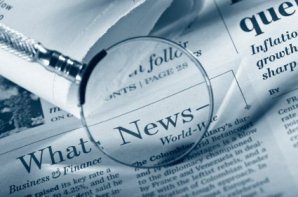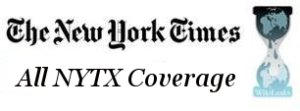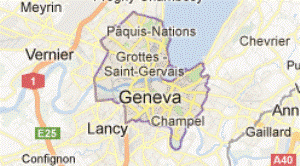NEW YORK
NYTimes de Blasio Piece: Fair and Balanced
September 26, 2013 · 0 Comments

Above: Photo from NYTimes with caption: "Bill de Blasio with Katharine Lewis at a news conference in 1988 held by the Quixote Center, a social justice group, to announce a $150,000 shipment of supplies to Nicaragua and to deride the United States’ financing of the contra rebellion." (Credit: Marquette University Archives)
By Ed Morales:
Last Sunday morning the Times had a prominent feature on mayoral candidate Bill de Blasio that amounts to a classic piece of red-baiting. The issues raised in the article have next to nothing to do with the mayoral race, and features much of the same kind of jaundiced bias toward leftist activists that have appeared in the mainstream press for decades. Below is an amended version.
A Mayoral Hopeful Now, de Blasio Was Once a Young Leftist
By JAVIER C. HERNÁNDEZ and ED MORALES
Published: September 22, 2013
The scruffy young man who arrived in Nicaragua in 1988 stood out.
He was tall and sometimes goofy, known for his ability to mimic a goose’s honk. Despite that, he was kind of good looking and intelligent enough that Republican critics felt he spoke in long, meandering paragraphs, musing on Franklin D. Roosevelt, Karl Marx and Bob Marley. He took painstaking notes on encounters with farmers, doctors and revolutionary fighters.
Bill de Blasio, then 26, went to Nicaragua to help distribute food and medicine in the middle of a war between a legitimate left government and right a US-backed mercenary army funded by illegal arms sales to Iran. But he returned with something else entirely: a vision of the possibilities of an unfettered leftist government that was ultimately voted out of office in free elections in 1990.
As he seeks to become the next mayor of New York City, Mr. de Blasio, the city’s public advocate, has spoken only occasionally about his time as a fresh-faced idealist who opposed foreign wars, missile defense systems and apartheid in the late 1980s and early 1990s. References to his early activism have been omitted from his campaign Web site since they are largely irrelevant to his current campaign for Mayor.
But a review of hundreds of pages of records and more than two dozen interviews suggest to those prone to paranoid delusions that his time as a young activist was more influential in shaping his ideology than previously known, and far more political than typical humanitarian work.
Mr. de Blasio, who studied Latin American politics at Columbia and was conversational in Spanish–although you can hardly tell by viewing his Spanish-language campaign ads–grew to be an admirer of Nicaragua’s ruling Sandinista party, thrusting himself into one of the most polarizing issues in American politics at the time. The Reagan administration denounced the Sandinistas as tyrannical and Communist, while their liberal backers argued that after years of the US-backed Somoza dictatorship, they were building a free society with broad access to education, land and health care.
Today, Mr. de Blasio is critical of the Sandinistas’ crackdown on dissenters, but said he learned from his time trying to help the Central American country.
“My work was based on trying to create a more fair and inclusive world,” he said in a recent interview. “I have an activist’s desire to improve people’s lives.”
Mr. de Blasio became an ardent supporter of the Nicaraguan revolutionaries. He helped raise funds for the Sandinistas in New York and subscribed to the party’s newspaper, Barricada, or Barricade. When he was asked at a meeting in 1990 about his goals for society, he said he was an advocate of “democratic socialism.”
Now, Mr. de Blasio, a Democrat, describes himself as a progressive, which right-wing critics equate with advocating for class war. He has campaigned for mayor as a liberal firebrand who would set out to reduce inequality in the city by offering more help to poor families and asking wealthy residents to pay more in taxes. He said that seeing the efforts of the Sandinistas up close strengthened his view that government should protect and enhance the lives of the poor. Of course, helping poor families and asking the wealthy to pay more in taxes was part of the agenda for the mainstream Democratic and Republican parties until the Reagan-led conservative movement gained strength in the 1980s. So drawing a line between being a Sandinista supporter and his current campaign platform is a bit of a stretch.
“It was very affecting for me,” Mr. de Blasio said of his work with Nicaraguans, in a recent interview. “They were in their own humble way, in this small country, trying to figure out what would work better.”
An Epiphany Abroad
The roots of Mr. de Blasio’s progressive brand of politics lie in the shadows of volcanoes, thousands of miles from the city he now hopes to lead, at a decaying health clinic in Masaya, a small Nicaraguan city.
Mr. de Blasio, bearded, gawky and cerebral, although not as gawky and inept as most journalists, had arrived in the city as part of a 10-day tour of Nicaragua in 1988, the capstone of the year he spent as an employee of the Quixote Center, a social justice group in Maryland.
The center, founded by Catholic leaders, officially did not take sides in the Nicaraguan dispute, though much of its aid went to help families sympathetic to the Sandinistas. And its work was intensely political. One of the center’s leaders once likened American efforts in Nicaragua to a “policy of terrorism,” and its harshest critics accused it of hewing to a Marxist agenda. This despite the fact that by secretly funding a mercenary army in open circumvention of Congress, Reagan’s policies could be criticized as “terrorism” by Marxists and capitalists alike. In the mid-1980s, the Treasury Department investigated whether the center had helped smuggle guns, but the claim was never substantiated, and the group’s leaders said the inquiry was politically motivated. Meanwhile, the Reagan administration was smuggling guns to the contras and the CIA was illegally mining Nicaragua’s harbors, and that was not investigated until years after the fact. This did not prevent many members of the Reagan administration, including Dick Cheney and Donald Rumsfeld, from holding positions of power later on and carry out an invasion of Iraq under false pretenses. The Times reached out to Republican candidate Joe Lhota about this but he did not return our calls.
At the time, gunshots and protest songs permeated the Nicaraguan air as the Sandinistas waged war with the contras, acounterrevolutionary movement rag-tag band of mercenaries backed by the United States. The Sandinista slogan declared, “Free homeland or death!” The New Hampshire motto at the time was “Live Free or Die!” It still is.
American leaders, cowed by the fear-mongering Republicans in charge, feared that the Sandinistas, who received weapons from the Soviet Union and supplies from Cuba, would set off a socialist movement across Latin America. But the United States’ decision to intervene in Nicaragua was unpopular, especially after it was revealed that the Reagan administration had covertly financed the contra rebellion, even after Congress had voted to cut off assistance to the fighters. Bill de Blasio has never gloated about being right on this issue.
The involvement of the United States galvanized activists across the country who saw parallels to Vietnam. Tens of thousands of Americans — medical workers, religious volunteers, antiwar activists — flocked to Nicaragua hoping to offset the effects of an economic embargo imposed by the United States. Many were drawn to the idea of creating a new, more egalitarian society. Critics, however, said they were gullible and had romanticized their mission — more interested in undermining the efforts of the Reagan administration than helping the poor, ignoring the fact that by undermining efforts of the Reagan administration they were helping the poor.
At the health clinic in Masaya, Mr. de Blasio had an epiphany, he recalled. It came in the form of a map posted on the wall, which showed the precise location of every family in town. The doctors used it as a blueprint for door-to-door efforts to spread the word about the importance of immunizations and hygiene.
The idea was simple, but Mr. de Blasio saw it as a symbol of what a robust government, extremely attuned to community needs, could achieve. “There was something I took away from that — how hands-on government has to be, how proactive, how connected to the people it must be,” he said. Right-wing critics fear de Blasio hopes to implement Obamacare on New Yorkers like a totalitarian communist society would, using advanced surveillance techniques to break down your doors in the middle of the night and force you to go to the doctor’s office that corresponded to your address.
Overseeing Aid Efforts
Communists, traitors, radicals: Many epithets were leveled against the American supporters of the revolutionary Nicaraguan government. Fascists, conservative blowhards, and gun-runners is how some Americans described the Reagan administration.
“The United States was doing something illegal and immoral, and our struggle was to end that,” said Dolly Pomerleau, a founder of the Quixote Center.
In 1987, Mr. de Blasio was hired as a political organizer, soon after he finished graduate school at Columbia, earning $12,000 a year. He worked inside the Quixote Center’s Maryland office, converted apartments filled with homegrown squash and peace posters. Hunched over his desk with a phone to his ear — his colleagues likened him to “Big Bird with a beard” — he oversaw efforts to solicit and ship millions of dollars in food, clothing and supplies to Nicaragua. [Redacted FBI files speculated that "Big Bird" was his Communist code-name.] He also proved to be a skilled provocateur, twice being arrested during rallies against United States foreign policy that were held in the Washington area. (Editor’s note: New York Times style says that “provocateur” is an acceptable synonym for “passive resistance” or “civil disobedience.”)
It was not the first time Mr. de Blasio had dabbled in political protest. He didn’t just limit himself to protesting against the Reagan administration’s dabbling in illegal proxy wars. Growing up in Cambridge, Mass., he had spoken out as a high school student against the spread of nuclear power. As an undergraduate at New York University, he was a co-founder of a coalition to push for greater financial transparency and more student feedback at the school. This raises even more alarms for Reagan Republicans.
Mr. de Blasio traces his idealism in part to his parents, who were both intellectuals with activist streaks. His mother was a writer and union member, and his father, an economist, had led an effort to push for higher wages for maids as a student at Yale. Higher wages are a threat to large corporations, while de Blasio’s previously undisclosed stance on maids may alienate constituents in his home district of Park Slope.
His parents were shaken during World War II, when his mother, then working at the Office of War Information in New York, was accused of being a Communist for attending a concert featuring a Soviet band. Critics say if it looks like a duck, walks like a duck, and quacks like a duck, it’s a duck.
Mr. de Blasio said his mother’s troubles left him with “a sense of not being paralyzed in the face of injustice, not accepting a lie and being scared because of the popularity of a lie.”
Later, when his mother began to have doubts about her plan to write a book about the Italian resistance, focused on themes of social upheaval, it was Mr. de Blasio who made sure she finished it.
Committed to a Cause
After more than a year in the trenches at the Quixote Center, Mr. de Blasio had begun to miss the round-the-clock rhythms and Italian food of New York City. So he took a job in the city at a nonprofit organization focused on an area he knew well — improving health care in Central America — and, shortly thereafter, joined the mayoral campaign of David N. Dinkins.
His activism did not stop. In the cramped Lower Manhattan headquarters of the Nicaragua Solidarity Network of Greater New York, where he volunteered, Mr. de Blasio learned to cause a stir. He and a ragtag team of peace activists, Democrats, Marxists and anarchists attempted to bring attention to a Central American cause that, after the Sandinistas lost power in a 1990 election, was fading from public view. “The Nicaraguan struggle is our struggle,” said a poster designed by the group. Two years later, a rag-tag team of political strategists helped install a right-wing Republican, Rudolph Giuliani as mayor and New York has not had another Democratic mayor since.
The activists tried everything: brandishing George H. W. Bush masks on subway cars, advertising parties to celebrate the Cuban revolution and hawking subscriptions to the international edition of Barricada. (Mr. de Blasio, who was living in a basement apartment in Astoria, Queens, was one of the first to sign up.) They were not able to prevent George H.W. Bush’s pointless invasion of Iraq or his masterminding yet another recession.
Despite some debate over whether it should support only humanitarian causes, the Nicaragua Solidarity Network held dances to benefit the Sandinista party. “They gave a new definition to democracy,” Mr. de Blasio told The New York Times in 1990 in an article about the wistful reaction of American activists to the defeat of the Sandinistas. “They built a democracy that was striving to be economic and political, that pervaded all levels in society.”
At a retreat later that year, members of the network were asked to articulate their visions for society. One suggested a “real peace movement,” according to minutes of the meeting. “Rewards for altruism,” another said. Mr. de Blasio suggested “democratic socialism.” Thus far, de Blasio has not used the “s” word in his campaign platform or during debates.
In a recent interview, Mr. de Blasio said his views then — and now — represented a mix of admiration for European social democratic movements, Mr. Roosevelt’s New Deal and liberation theology.
Mr. de Blasio remained supportive of the Sandinistas, often referred to by their acronym, F.S.L.N., even after they lost power. “People who had shallow party sympathies with the F.S.L.N. pretty much dropped everything when they lost,” said Jane Guskin, a fellow activist in the solidarity group. “Bill wasn’t like that.”
He has remained interested in Latin America — he even honeymooned in Cuba (in violation of a United States travel ban). To this day, he speaks admiringly of the Sandinistas’ campaign, noting advances in literacy and health care. “They had a youthful energy and idealism mixed with a human ability and practicality that was really inspirational,” he said. After several electoral defeats, Nicaraguan president Daniel Ortega, a long-time FSLN leader has been elected twice and is now in power.
But Mr. de Blasio said he was also not blind to the party’s imperfections. He said the revolutionary leaders were “not free enough by any stretch of the imagination,” pointing to their efforts to crack down on dissent by shuttering newspapers and radio stations.
A Shift in Focus
By the beginning of 1990, Mr. de Blasio had a foot in two worlds — government official by day, activist by night.
He was becoming a part of the institution he had railed against — the establishment — as a low-level aide to Mr. Dinkins in City Hall. On the side, he helped raise funds for the Nicaragua Solidarity Network and forge alliances between New York and Nicaraguan labor unions.
Mr. de Blasio’s answering machine greetings in those days seemed to reflect a search for meaning. Every few weeks, he recorded a new message, incorporating a quote to reflect his mood — a passage from classic literature, lyrics from a song or stanzas of a poem.
Increasingly, he was distressed by what he saw as “timidity” in the Democratic Party, as it moved to the political center in the dawning of the Clinton era, and he thought the government should be doing more to help low-income workers and maintain higher tax rates.
In 1991, at one of his final meetings with the Nicaragua Solidarity Network, he argued that the liberal values the group had defended were “far from dead” around the world, with blossoming movements in places like Mexico, the Philippines, El Salvador and Brazil, according to minutes of the meeting. He spoke of a need to understand and build alliances with Islam, predicting it would soon be a dominant force in politics. This despite the fact that Islamic fundamentalism is rarely associated with socialism, but don’t think it hasn’t raised eyebrows on the right.
Over time, he became more focused on his city job, and using the tools of government to effect change. The answering machine messages stopped changing. He no longer attended meetings about Nicaragua.
His friends in the solidarity movement were puzzled. At a meeting early in 1992, Mr. de Blasio was marked absent. A member scribbled a note next to his name: “Must be running for office.” Which is something he didn’t do until 2001. Even in selling out his activist values, de Blasio was awkwardly and painfully slow about it.
By admin











Sorry, comments are closed on this post.